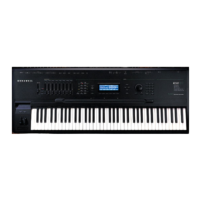Global Mode
Enter Storage Page
6-18
Load Page
Select the Load page to load compatible les from a storage device.
Use the NAVIGATION Up/Down buttons or the ALPHA WHEEL to browse the les in
the storage device.
Press the FAVORITES 2 button to open the selected directory.
Press the FAVORITES 1 button to move one level back from the current directory.
After selecting a le to load, press the ENTER button to continue, then use the CHANNEL/
PAGE buttons to select the page for your desired loading method: Fill, Overwrite or Merge.
See below for details on each loading method.
Load Fill Page
Select the Storage Load Fill page to load objects with the Fill method. e Fill method keeps
existing User objects in the keyboard, and loads the User objects from the le into empty
User ID locations in the keyboard.
On the Storage Load Fill page, choose the User ID number at which you would like to begin
loading objects. is allows you to organize your user objects if desired by loading them to
specic ID ranges. Your User objects may be loaded to higher IDs than selected, if IDs in the
selected range are already used.
Load Overwrite Page
Select the Storage Load Overwrite page to load objects with the Overwrite method. e
Overwrite method deletes existing User objects in the keyboard, then loads the User objects
from the le using the ID numbers stored in the le. is is useful for loading a backup le
of user objects, to restore the instrument to a previous state.
Load Merge Page
Select the Storage Load Merge page to load objects with the Overwrite method. e merge
method loads the user objects from the le using the object ID numbers stored in the le,
only deleting existing objects in the keyboard which use the same ID numbers. Existing user
objects that use other IDs will not be deleted. is is useful for loading a backup le of user
objects, to restore the instrument to a previous state while keeping some existing user objects.

